People's Knowledge and Opinions about getting Dental Implants with other Conventional Treatment Modalities in Herat City Habitats, Afghanistan
Abstract
Objectives
This study aimed to evaluate the people's understanding, expectations, and knowledge of dental implants compared with other treatment modalities as a treatment option for replacing missing teeth among a selected sample of Herat urban habitats in Herat City, Afghanistan.
Materials and Methods
This descriptive cross-sectional study was done on a randomly selected 420 Heart City habitats from all 15 districts over one month, from May to June 2022, to assess the knowledge and opinion of Herat City habitats toward dental implants as an option for replacing missing teeth. An organized questionnaire collected the data with open questions, a direct interview, and the introduction and demonstration of a short animation about the dental implant procedure. The data were categorized by similar answers, interred, and analyzed with IBM-SPSS version 25.
Results
Among the 420 participants in this study, 67.9% of respondents had heard about dental implants, and 28.6% had information about dental implant and surgical procedure. Among all participants, 59% preferred dental implants for their missing teeth replacement, and 3.8% had received dental implants before. Education significantly influenced the information about surgical procedures of dental implants (p < 0.05), knowledge about dental implants (p < 0.05), and priority of dental implants for missing teeth replacement (p < 0.05). According to the source of information, most of them got information from medical staff and their family and friends. Other sources of information are dedicated to television, cyberspace, and advertisements.
Conclusion
The survey concluded that there was an unacceptable level of awareness regarding using dental implants as a treatment option for replacing missing teeth. Medical staff, family, and friends are the main sources of information. The level of education has an essential role in knowledge and awareness about dental implants.
1. INTRODUCTION
In ancient times, the inability to effectively bite and masticate processed food minimally threatened one’s survival [1]. With the increase in contemporary dental techniques, replacing missing teeth has become possible and desirable [2].
Ancient Egyptian and South American civilizations did fabricate implants to replace teeth [3]. The implants were made from other animals’ teeth or carved ivory. It is doubtful whether these implants functioned without early failure [2]. The first recorded case of a replacement tooth made of metal was from an Egyptian king who lived approximately 1000 BC [4].
With advancements and increased knowledge in dentistry, more people tend to keep more teeth until later in life [1]. Dental implants are popular because they preserve adjacent tooth structures and bone [5]. Replacement of tooth roots was performed in Europe in the 17th century using various materials and animal parts [2].
The history of the dental implant in Afghanistan dates back to 2004. Evidence shows that Professor Rashid Chughtai from Pakistan was the pioneer and first academic to start oral implantology in the National and Specialized Stomatology Hospital in Kabul, Afghanistan. He used the monoblock system (MB; Odontit, Argentina), which is assumed to be the first use of oral implantology in Afghanistan.
A dental implant is an artificial root inserted surgically to support the complete denture or replace a single tooth or maxillofacial prosthesis [6]. Recently, it has been widely accepted as a prosthetic treatment option compared to conventional methods [7]. Although several prosthodontic options for replacing missing teeth are available, some researchers have highlighted that the acceptability of these options depends on the patient’s education, economy, cultural background, and age [8]. The main role of prosthodontics is the rehabilitation of patients after the loss of teeth and oral function [9]. Moreover, the high incidence of tooth loss observed in second molars has a crucial functional role.
Understanding what patients know about dental implants and where they obtain their knowledge is essential for improved clinical care [10]. In clinical cases, where more treatment options are possible, the levels of patients’ education and awareness of different treatment modalities significantly affect the final treatment decision [11]. Furthermore, awareness of dental implants is increasing among the general public, and more and more patients are seeking information about dental implants [12]. Several studies have shown the patients’ awareness of oral implants in different countries [13].
With patients’ increasing demand for implant-supported superstructures, dentists dealing with implantology face patients’ high expectations concerning optimal esthetic and function. Moreover, media reports such as ‘implant forever’ or ‘implants last lifelong because of high and unrealistic patient expectations [13-16].
People globally and even in third-world countries like Afghanistan, who have suffered from war and poverty over many years, care about their appearance. Although these people are scarce, that number is increasing with greater knowledge and awareness [17, 18].
2. MATERIALS AND METHODS
This descriptive cross-sectional study was done over one month, from May to June 2022, to assess and evaluate the knowledge and opinion of Herat City inhabitants concerning dental implants as an option for replacing missing teeth. Before data collection, protocol number 02-28042022 obtained approval from the ethical committee of the faculty of medicine, Herat University, Herat, Afghanistan.
The inclusion criteria were people 18y or older, with no disability, a citizen of Heart City in the last three years, and cooperative. The exclusion criteria were people less than 18y, with any disability or mental problem, people from a rural area or other provinces, and people not prepared to cooperate.
All participants gave informed consent. The participant signed the consent form after a short, direct interview and study description. A questionnaire with two main sections was prepared. The demographic information (age, sex, educational level, marital status, and habitation) and the questions section with 16 questions elucidating people's knowledge, attitude, and trust concerning receiving a dental implant as an option for missing teeth replacement treatment.
The study was conducted all around the 15th district of Heart City with direct and face-to-face interviews. Before starting the interview and asking the questions, a short introduction and animation concerning dental implants and the procedures from start to finish were demonstrated. Then, the participants answered the questions by themselves (her/his self) or with the interviewer. The answers were interpreted and analyzed by IBM-SPSS version 25 (SPSS, version 25, IBM Corp).
3. RESULTS
Four hundred twenty participants were questioned during the study period. Among the 420 subjects, 60.5% were male, and 39.5% were female. According to occupation, 41.9% were students, 29.3% were self-employed, 20% were office-employed, and 8.8% were housewives (Tables 1 and 2).
| Gender | Frequency | Percent | Valid Percent | |
|---|---|---|---|---|
| Valid | Male | 254 | 60.5 | 60.5 |
| Female | 166 | 39.5 | 39.5 | |
| Total | 420 | 100.0 | 100.0 |
Table 2.
| - | Frequency | Percent | Valid Percent | |
|---|---|---|---|---|
| Valid | Student | 176 | 41.9 | 41.9 |
| Office employee | 84 | 20.0 | 20.0 | |
| Self-employed | 123 | 29.3 | 29.3 | |
| Housewife | 37 | 8.8 | 8.8 | |
| Total | 420 | 100.0 | 100.0 |
Most participants preferred dental implants to replace their missing teeth 59%, then fixed partial dentures (FPD) 19%, and removable partial dentures (RPD) 10%, respectively (Fig. 1).
Among Four hundred twenty participants, 67.9% heard about dental implants, and 32.1% did not hear about them (Fig. 2). Most participants received information from medical staff 35.03%, and their family and friends 29.59%. Information was received from TV, cyberspace, and advertisements by 21.43%, 10.88%, and 3.06%, respectively (Fig. 3).
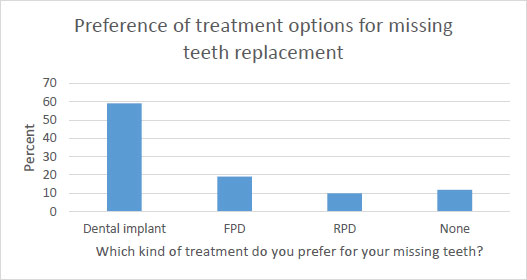
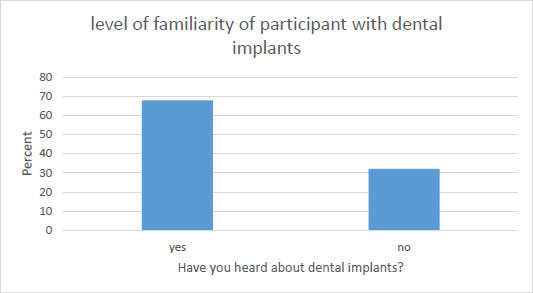
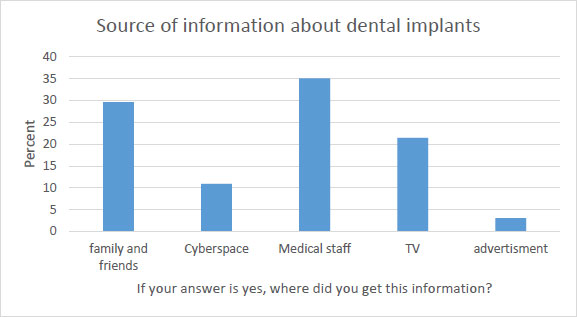
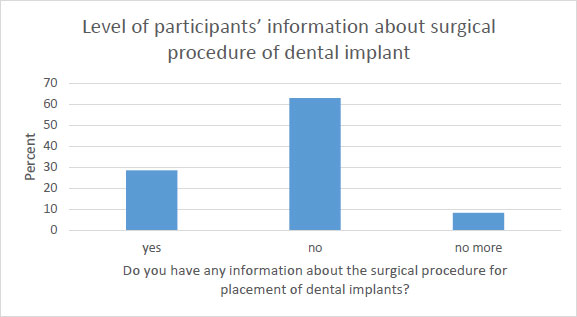
The responses were mostly negative according to participants' knowledge of the surgical procedure for dental implant placement; 91.7% and 8.3% answered they had no knowledge, and 28.6% responded they knew (Fig. 4).
Of the level of preference for dental implants as a treatment for missing teeth, 80% of participants agreed, and 20% did not agree with the placement of dental implants as a treatment option for their tooth-missing replacement.
All participants were asked why they chose dental implants to replace missing teeth, 54.8% stated that these are very stable and comfortable, 18% answered they‘re safe and protected the other teeth, 14.2% emphasized esthetic reasons, 8.5% stated it is better and newer than other treatment modalities, and 4.5% believed implants have a long life durability (Fig. 5). The remaining 20% participants disagree with implant treatment for their tooth-missing replacement; the most significant reason being the economic situation 42.1%, fear of surgical procedures 29%, the preference for RPD 15.8% and pain after surgery 13.2% (Fig. 6).
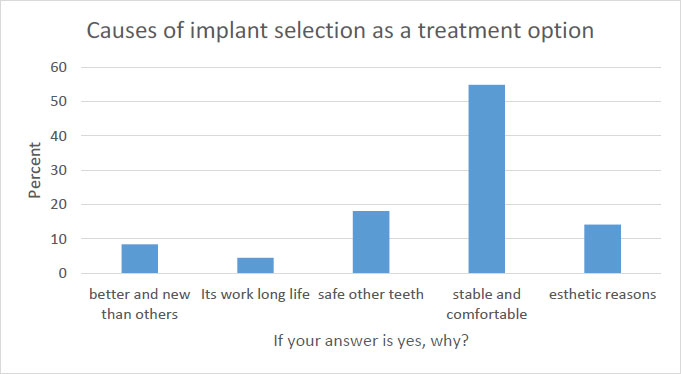
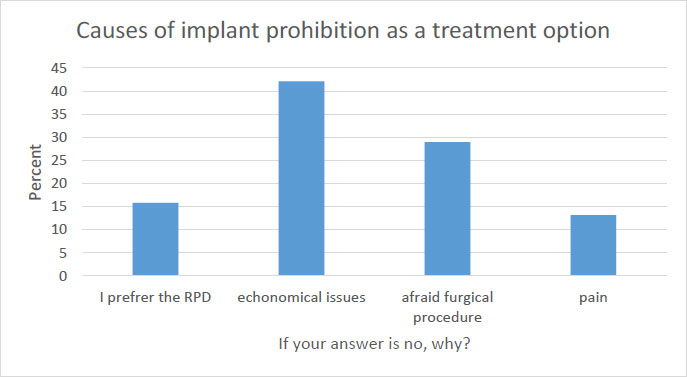
According to the question as to how many years an implant can survive in the mouth, the answers were 21.9% for long life, 21.2% more than ten years, 19% between 6-10 years, 19% for 1-5 years, and 2.6% less than one year (Fig. 7).
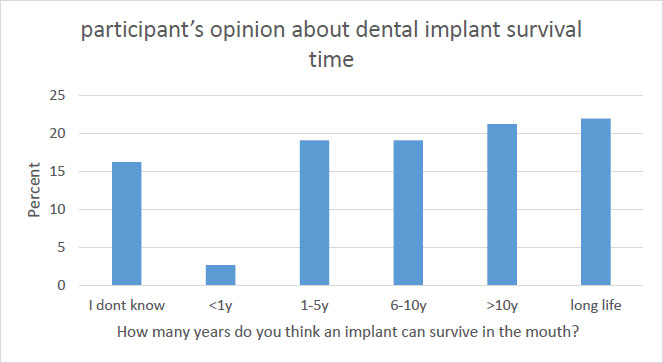

Participants' level of trust and confidence according to dental implant treatment in Afghanistan is also evaluated. Among all four hundred twenty people, 61.4% trust implant treatment in Afghanistan.
The relation between gender (male, female) and the type of treatment they prefer for their missing teeth was significantly different (p < 0.05). Females prefer implants more and disagree with RPD (Fig. 8).
The relation between education and information about the surgical procedure for the placement of dental implants was significant (p < 0.05). Education has a prominent role in people's awareness (Fig. 9).
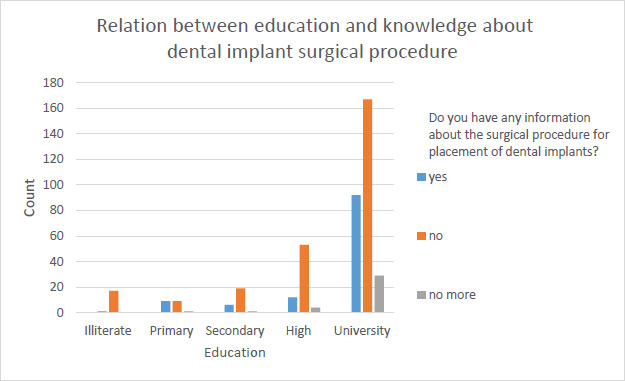
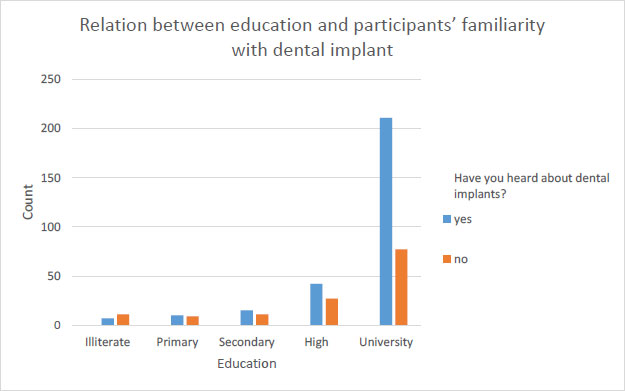
The relation between education about dental implants showed a significant relationship between education and people's knowledge about dental implants (p < 0.05) (Fig. 10).
64.2% of educated people agreed with dental implants. The less educated people were indifferent and not very eager to receive implants; 44.4% did not wish to receive implant treatment for replacing their missing teeth, and it was significantly different from the educated people (p < 0.05) (Fig. 11).
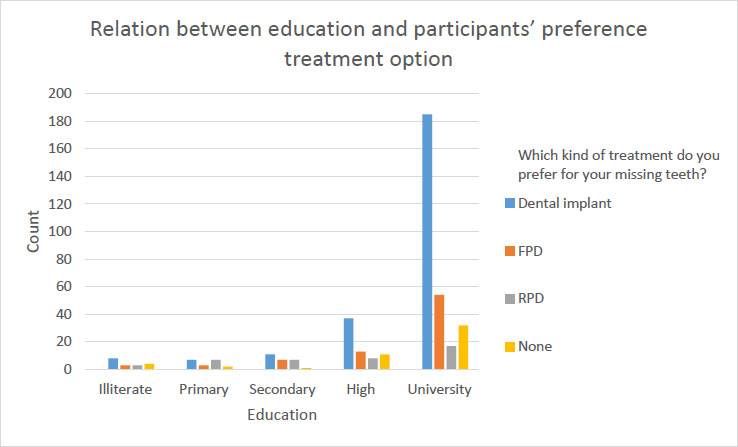
The relationship between hearing about dental implants and years of dental implant survival in the mouth showed a significant difference (p < 0.05) (Fig. 12). In addition, evaluation and comparison between hearing about dental implants and having information about the surgical procedure for placement of dental implant point was highly significant (p < 0.05) (Fig. 13).
The relationship between age and type of treatment preferred for their missing teeth was evaluated, and a willingness to receive dental implants decreased with age. Interest in implant treatment was much higher in young people than in older people, and this difference was significant (p < 0.5) (Fig. 14).
4. DISCUSSION
The present study assessed the knowledge, source of information, attitude, and trust of Herat City inhabitants regarding using dental implants to replace missing teeth. In the present study, 67.86% of respondents heard about implants, and 28.57% heard about the surgical procedure of dental implants. The results found by Alajlan et al. show that 91.5% of Saudi Arabia had heard about dental implants [14].
According to Suprakash et al., a significant gender difference (p < 0.05) was found in the knowledge, with the female having a lower mean score than the male. Patients' knowledge and attitude toward dental implants increased with increased education and decreased with increased age, similar to this study [9].
According to the durability of dental implants, the results found by Alajlan et al. in Saudi Arabia show that most participants believed dental implants survive more than 20 years [14].
According to the source of information about dental implants, the study launched by Alajlan et al. found a result similar to this study [14]. The dentists, family, and friends were the main sources of information.
The level of participants’ awareness about dental implants was significantly affected by age and education [15]. The results found by Kranjcic et al. confirm that the majority of participants, 81.8%, from ages younger than 65 years, have heard about dental implants [11]. According to choosing a dental implant as an option for replacing missing teeth and being afraid of the surgical procedure implant, the difference between males and females was significant (P < 0.05) [9].
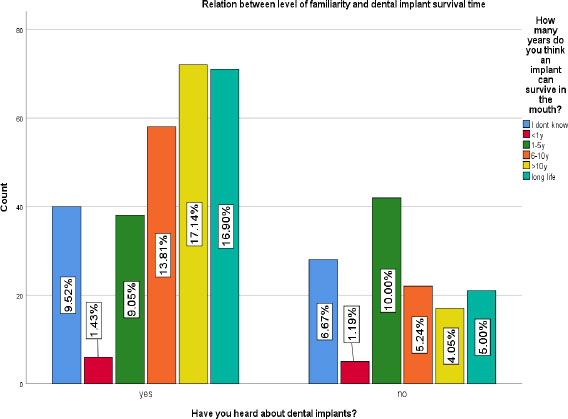
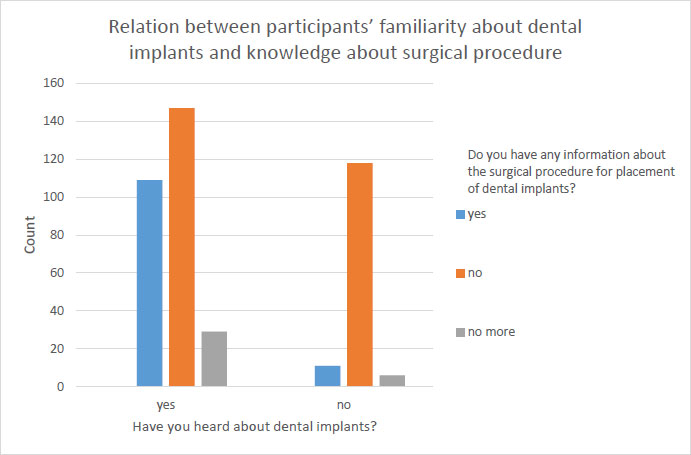
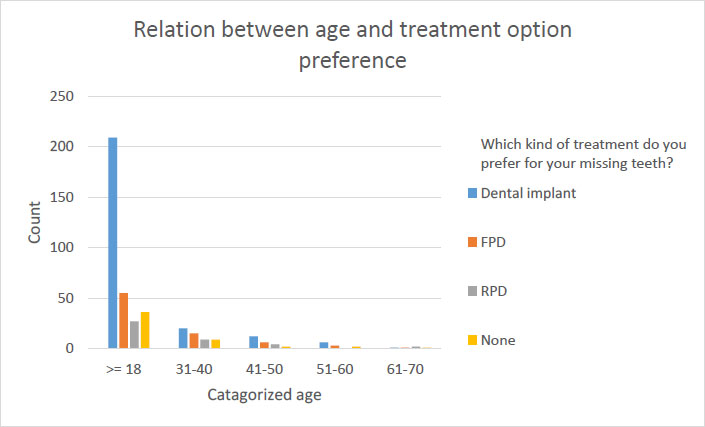
The results of this study about alternatives for replacing missing teeth were similar to the survey done by Pommer et al. [19]; 79% of their interviewees mentioned dental implants, 45% RPD, 77% indicated complete removable denture, and 91% fixed partial denture [19]. In addition, among the significant disadvantages of implants, high costs were cited by 83% of the total sample, the need for surgery by 53%, and the lengthy treatment time by 16% [19]. They mentioned the primary source of information about dental implants was the dentists 74%, followed by friends and acquaintances 30%, printed media 26% and the general practitioner 7% [19]. When asked about the survival rate of the dental implant, the results were 5% up to 5 years, 27% up to 10 years, 30% up to 20 years, and 24% expected the implant to last for a lifetime, which was similar to this study [19].
CONCLUSION
The present study concluded that the Herat city inhabitants’ knowledge about dental implants and surgical procedures was inappropriate. Most of the participants preferred dental implants as a choice for missing teeth replacement. Stable and comfort are the most common reasons for dental implant acceptance as treatment of missing teeth, and the denying reasons are economic situations, fear of surgery, pain, and age. Education, gender, and age played a significant role in the knowledge of getting dental implants as an option for missing teeth replacement. According to the source of information, most of them got information from medical staff and their family and friends. The TV, cyberspace, and advertisements are dedicated.
AUTHORS' CONTRIBUTIONS
Conceptualization: EO, MH; methodology: EO, MH; investigation: EO; data organization EO; writing of the draft MH; review of the draft: EO, MH. All authors read and approved the final manuscript.
LIST OF ABBREVIATIONS
| SPSS | = Statistical Package for the Social Sciences |
| MB | = Monoblock |
| FPD | = Fixed Partial Dentures |
| RPD | = Removable Partial Dentures |
| TV | = Television |
| BC | = Before Christ |
ETHICS APPROVAL AND CONSENT TO PARTICIPATE
This study was conducted under the approval of the ethical committee of the faculty of medicine, Herat University, Herat, Afghanistan (protocol number 02-28042022).
HUMAN AND ANIMAL RIGHTS
No animals were used. All procedures performed in studies involving human participants were by the ethical standards of institutional and/or research committees and with the 1975 Declaration of Helsinki, as revised in 2013.


